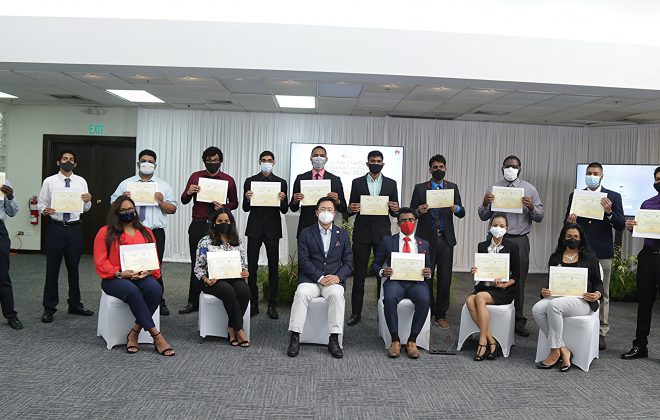CANTO WEEKLY NEWSLETTER – BNamericas
Friday, August 17, 2018
| Kaspersky notes 60% spike in LatAm malware attacks – Regional
Lower tariffs, data protection policies needed to boost e-trade in LatAm – IDB – Brazil, Regional Brief: Brazil sees hike in online Father’s Day sales – Brazil Xiaomi chooses Colombia for first LatAm store – Colombia WOM joins legal scrap over use of Chile’s 3.5GHz band – Chile |
| Our Mission “Influence the innovation and development of ICT solutions for the benefit of members by developing, navigating and leveraging relationships with all stakeholders.” “Advocate for policies, legislation and rules which advance the creation of an environment which facilitates the deployment of services and technologies around the region.” |
| Vision “To become the leading authority in shaping information, communication and technology in the Caribbean Region and the Americas.” |
| Kaspersky notes 60% spike in LatAm malware attacks – Regional
Kaspersky Lab registered 746,000 malware attacks daily over the last 12 months, representing nine attacks per second, a 60% increase compared to 2017. Phishing attacks continue to be the most prevalent, with Venezuela representing the largest number of attacks in proportion to the population (70.4%), followed by Brazil (64.4%) and Bolivia (63.3%), the company said in a statement released during its Latin American Security Analysts forum in Panama. Brazil is the country hosting the largest proportion of malware, representing 50% of the total registered in Latin America. The largest percentage of attacks happen to individual users rather than companies, when they are online, downloading files or opening attachments. However, companies are more vulnerable to malicious e-mail and offline attacks (virus-infected USBs) as well as breaches due to use of pirated software. Dmitry Bestuzhev, head of Kaspersky Lab’s research and analysis team for Latin America, commented that Brazil was a hotbed for the Powedon Trojan, which is propagated via the Microsoft Windows task automation and configuration management framework Powershell. “Criminals are abusing this functionality for criminal activity,” Bestuzhev said. MOBILE MALWARE Kaspersky registered a rise of 31.3% in security breaches via mobile, mainly Android, devices. The principal mobile malware registered in Latin America was Trojan Boogr.gsh, which is propagated via malicious adware that collects data without user consent and affects device performance. Other Trojans frequently detected include Backdoor.AndroidOS.GinMaster.b, which can access mobile devices and explore and extract content. MALWARE FOR MAC Kaspersky found that attacks on MacOS users fell 14.9%, which according to market observers is due to the higher cost of these devices, make them not accessible to a wide range of users. However, the Trojan JS.Miner.m is commonly found in both Mac and PC as well as iOS and Android devices. In this case, the operating system is irrelevant as the attack occurs through the browser. Trojan.PDF.Phish also affects users of all operating systems as it infects through PDFs which carry a special type of phishing malware that persuades victims to hand over passwords in order to read the content of the document. PHISHING Six countries in Latin America are among the top 20 in the world for phishing attacks led by Brazil and also including Chile, Argentina, Peru, Guatemala and Venezuela. According to Kaspersky Lab senior security analyst Fabio Assolini, in Brazil cyber criminals use e-mail, SMS, phone calls and social networks to contact potential victims under the auspices of well-known brand names, which lulls them into a false sense of security and facilitates the spread of these viruses. Some 40mn such attacks were blocked in Latin America this year alone, Assolini said. TIME OF YEAR The most popular time for attacks in Latin America is Black Friday. Last year, when the event took place on November 23, 380,000 phishing attacks were blocked just that day, four times that of a normal day. Cyber criminals take advantage of the shopping frenzy to send e-mails with alleged special offers which redirect victims to false websites where they type in credit card and other payment details. Lower tariffs, data protection policies needed to boost e-trade in LatAm – IDB – Brazil, Regional Latin American and Caribbean (LAC) nations should look at increasing collaboration in intra-regional data and consumer protection policies, as well as setting minimum tariff levels to boost the area’s lagging digital trade and e-commerce footprint, according to a report by the Inter-American Development Bank (IDB). Countries in the region should also focus on avoiding costly data localization requirements (when information is required to remain within the borders of a country, thus increasing costs) and joining international trade and ICT agreements to help streamline processes, the report adds. “The region accounts for 8.2% of economic activity worldwide, yet only 5.1% of global exports. In terms of trade openness-total exports to GDP-this represented 44 percent of GDP, below other emerging market economies,” the multilateral lender said. Regional trade blocs Mercosur and the Andean Community (CAN) have done a poor job so far of increasing intra-regional trade, the IDB added. As of 2015, only 8% of all trade from CAN countries went to the four country bloc’s domestic markets, while Mercosur trade accounted for 14%. As a comparison, the European Union’s 28 countries kept 65% of trade within their borders, while the figure was 50% for the North American Free Trade agreement (Nafta), it said. Brazil stands out as the leader in e-commerce in the region with around 3% of all retail conducted online last year, the report read. It added that “constraints on e-commerce in LAC include the low quality and high cost of internet services, the limited availability of international electronic payment options, and the monetary and time costs imposed by transportation and customs procedures on high-volume and low-value items. Regulatory differences and other trade barriers amongst countries in the region, such as investment restrictions and the absence of common privacy or consumer protection laws also increase the cost of cross-border e-commerce.” It issued 22 recommendations ranging from expanding cooperation in cybersecurity, a hot topic after serious banking hacks took place recently in Chile and Mexico, to promoting electronic payment systems and regional data protection policies, amongst others. “The need for LAC to engage in digital trade is acute. LAC’s share of global trade over the past decade has declined and trade within the region as [a] share of total trade trails other major trade zones. Building a digital economy through effective digital trade rules and complementary domestic reforms will help LAC achieve the economic diversification and innovation-driven growth needed to reverse these trends,” it concluded. Brief: Brazil sees hike in online Father’s Day sales – Brazil Brazilian online retailers reported over 2.1bn reais (US$541mn) in sales for Father’s Day, celebrated on Sunday, August 12, according to local e-commerce consultancy firm Ebit and polling institute Nielsen. The result was 8% higher than for Father’s Day in 2017. Ebit considered sales between July 28 and August 11. The number of items purchased rose 22% to 5.11mn, while the average sales receipt fell 11.5% to 409 reais. According to Ebit director Pedro Guasti, the drop in the average receipt was impacted directly by the sale of products with lower-added value such as books, shoes, supplements, perfumes, shirts and wine. “This shows that virtual consumers are still quite wary of buying expensive products and incurring debt,” he said. Xiaomi chooses Colombia for first LatAm store – Colombia Chinese mobile phone brand Xiaomi will open a store in Bogotá, Colombia, its first in Latin America, the company’s Latin America sales director Joseph Jin was reported as saying by newspaper La República. Jin said that the store would be open as from August 16 in the Gran Estación shopping mall. “Colombia is a key country in the region, not so much due to the size of the market, but because of the characteristics of its users, which we have found to be very demanding when purchasing technology. That has helped raise the value of our brand when presenting high level products at accessible prices,” Jin said. According to consultancy IDC, Xiaomi saw the largest growth amongst the top five smartphone vendors in Q2, with 31.9mn units shipped, up 49%, which increased its market share to 9.3% from 6.2% a year earlier. The company has focused on a value-for-money approach, with dual-camera models priced at US$150, says IDC. In terms of growth Xiaomi outperformed fellow Chinese vendor Huawei, which saw a 40.9% rise in shipments and a 43% increase in market share to 15.8%. Huawei overtook Apple to become the world second largest vendor behind Samsung, which commands a 20.9% market share, driven by strong sales of its flagship P20 and its sub-brand Honor. In China, Xiaomi is also the fourth largest smartphone vendor with a 13.8% market share in 2Q18 behind Huawei, Oppo and Vivo, meanwhile in India, Xiaomi has displaced Samsung as the top vendor and is closing in on Samsung in Indonesia. However, Xiaomi’s move into Latin America has been slow. In June 2015, Brazil became Xiaomi’s first market outside of Asia. But the brand left several years later due to the competitive nature of the Brazilian handset market that offers little room for unknown brands, and with a commercial model privileging online sales. Xiaomi downsized operations and closed a local manufacturing center it had opened through an outsourcing deal with Foxconn. WOM joins legal scrap over use of Chile’s 3.5GHz band – Chile Chilean mobile operator WOM has joined a legal spat over a controversial decision by telecoms watchdog Subtel to ban the use of the 3.5GHz band. Even though WOM does not hold a license for that band, the company said in a letter sent to the court of appeal that it felt obliged to get involved in the dispute given that the 3.5GHz band is intended to be used for 5G, which will impact Wom’s future plans. In June, Subtel ordered the concessionaires of 3.5GHz – Entel, Claro, Movistar, Gtd (Telsur) and VTR – to stop using it, claiming the spectrum was being underused and that the regulator wanted to study the use of the band for 5G in the future. WOM is participating as an “interested third party,” a similar status to that of cable operator VTR (Liberty Latin America) and Movistar (Telefónica), which both hold licenses in the 3.5GHz band. In its statement, reported by local press, WOM said that the outcome of the dispute “would undoubtedly affect the other telecommunications operators.” WOM referred to Entel and Claro, who are the two operators mostly using the band, as an “oligopoly.” Entel and Claro filed separate lawsuits appealing Subtel’s decision, although their legal action is being considered together as a single case. The two companies have called the watchdog’s move illegal and unconstitutional. Entel holds the largest portion of 3.5GHz (100MHz) and claims it has some 30,000 customers using it for fixed wireless residential services and has invested more than US$100mn in developing that network. The other operators hold 50MHz each. VTR’s legal and regulatory affairs head, Miguel Oyonarte, told local press last week that the company had decided to get involved in the legal dispute because dialogue had failed. Meanwhile, Movistar has expressed its support for Subtel in making the most efficient use of the band possible. The information presented and opinions expressed herein are those of the author and do not necessarily represent the views of CANTO and/or its members
[GRAFICO:FIGURA:ID_5959_1534435868154] |



